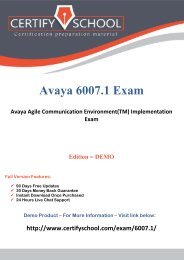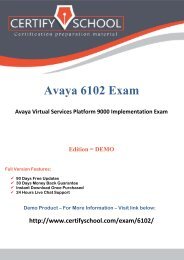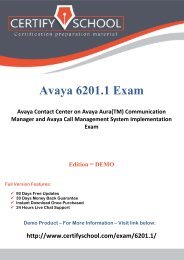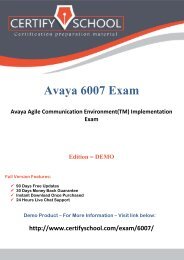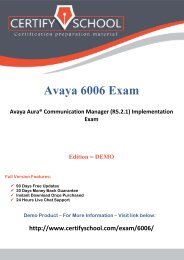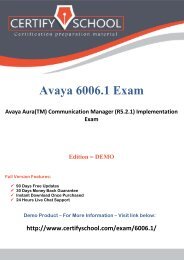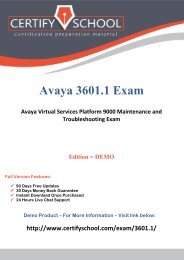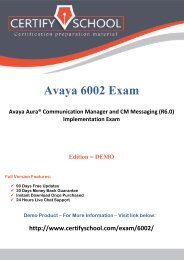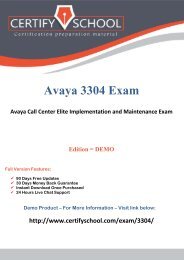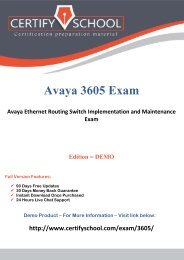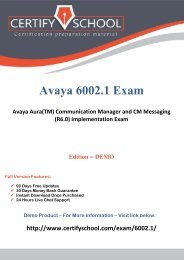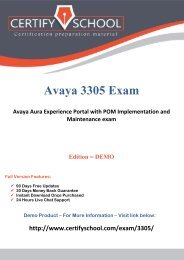70-433 Exam
For more Full product Details:www.CertifySchool.com Our workable study material for exam meets the exact and accurate exam questions and answers. So that’s why CertifySchool is popular in the field of IT Certification Exams material providers.Please visit site: www.CertifySchool.com/
For more Full product Details:www.CertifySchool.com
Our workable study material for exam meets the exact and accurate exam questions and answers. So that’s why CertifySchool is popular in the field of IT Certification Exams material providers.Please visit site: www.CertifySchool.com/
You also want an ePaper? Increase the reach of your titles
YUMPU automatically turns print PDFs into web optimized ePapers that Google loves.
www.CertifySchool.com Certification Preparation Material (PDF)<br />
Microsoft <strong>70</strong>-<strong>433</strong> <strong>Exam</strong><br />
TS: Microsoft SQL Server 2008, Database Development<br />
Edition = DEMO<br />
Full Version Features:<br />
90 Days Free Updates<br />
30 Days Money Back Guarantee<br />
Instant Download Once Purchased<br />
24 Hours Live Chat Support<br />
Demo Product – For More Information – Visit link below:<br />
http://www.certifyschool.com/exam/<strong>70</strong>-<strong>433</strong>/<br />
http://www.certifyschool.com/exam/<strong>70</strong>-<strong>433</strong>/<br />
Page | 1
www.CertifySchool.com Certification Preparation Material (PDF)<br />
Question: 1.<br />
You have a user named John. He has SELECT access to the Sales schema. You need to eliminate John's SELECT access<br />
rights from the Sales.SalesOrder table without affecting his other permissions. Which TransactSQL statement should<br />
you use<br />
A. DROP USER John;<br />
B. DENY SELECT ON Sales.SalesOrder TO John;<br />
C. GRANT DELETE ON Sales.SalesOrder TO John;<br />
D. REVOKE SELECT ON Sales.SalesOrder FROM John;<br />
Question: 2.<br />
Answer: B<br />
You need to create a column that allows you to create a unique constraint. Which two column definitions should you<br />
choose (Each correct answer presents a complete solution. Choose two.)<br />
A. nvarchar(100) NULL<br />
B. nvarchar(max) NOT NULL<br />
C. nvarchar(100) NOT NULL<br />
D. nvarchar(100) SPARSE NULL<br />
Question: 3.<br />
Answer: AC<br />
You manage a SQL Server 2008 database that is located at your company's corporate headquarters. The database<br />
contains a table named dbo.Sales. You need to create different views of the dbo.Sales table that will be used by each<br />
region to insert, update, and delete rows. Each regional office must only be able to insert, update, and delete rows<br />
for their respective region. Which view should you create for Region1<br />
A. CREATE VIEW dbo.Region1Sales<br />
AS<br />
SELECT SalesID,OrderQty,SalespersonID,RegionID<br />
FROM dbo.Sales<br />
WHERE RegionID = 1;<br />
B. CREATE VIEW dbo.Region1Sales<br />
AS<br />
SELECT SalesID,OrderQty,SalespersonID,RegionID<br />
FROM dbo.Sales<br />
WHERE RegionID = 1<br />
WITH CHECK OPTION;<br />
C. CREATE VIEW dbo.Region1Sales<br />
WITH SCHEMABINDING<br />
AS<br />
SELECT SalesID,OrderQty,SalespersonID,RegionID<br />
FROM dbo.Sales<br />
WHERE RegionID = 1;<br />
D. CREATE VIEW dbo.Region1Sales<br />
http://www.certifyschool.com/exam/<strong>70</strong>-<strong>433</strong>/<br />
Page | 2
www.CertifySchool.com Certification Preparation Material (PDF)<br />
WITH VIEW_METADATA<br />
AS<br />
SELECT SalesID,OrderQty,SalespersonID,RegionID<br />
FROM dbo.Sales<br />
WHERE RegionID = 1;<br />
Question: 4.<br />
Answer: B<br />
You administer a SQL Server 2008 database that contains a table name dbo.Sales, which contains the following table<br />
definition:<br />
CREATE TABLE [dbo].[Sales](<br />
[SalesID] [int] IDENTITY(1,1) NOT NULL PRIMARY KEY CLUSTERED,<br />
[OrderDate] [datetime] NOT NULL,<br />
[CustomerID] [int] NOT NULL,<br />
[SalesPersonID] [int] NULL,<br />
[CommentDate] [date] NULL);<br />
This table contains millions of orders. You run the following query to determine when sales persons comment in the<br />
dbo.Sales table:<br />
SELECT SalesID,CustomerID,SalesPersonID,CommentDate<br />
FROM dbo.Sales<br />
WHERE CommentDate IS NOT NULL<br />
AND SalesPersonID IS NOT NULL;<br />
You discover that this query runs slow. After examining the data, you find only 1% of rows have comment dates and<br />
the SalesPersonID is null on 10% of the rows. You need to create an index to optimize the query. The index must<br />
conserve disk space while optimizing your query.<br />
Which index should you create<br />
A. CREATE NONCLUSTERED INDEX idx1<br />
ON dbo.Sales (CustomerID)<br />
INCLUDE (CommentDate,SalesPersonID);<br />
B. CREATE NONCLUSTERED INDEX idx1<br />
ON dbo.Sales (SalesPersonID)<br />
INCLUDE (CommentDate,CustomerID);<br />
C. CREATE NONCLUSTERED INDEX idx1<br />
ON dbo.Sales (CustomerID)<br />
INCLUDE(CommentDate)<br />
WHERE SalesPersonID IS NOT NULL;<br />
D. CREATE NONCLUSTERED INDEX idx1<br />
ON dbo.Sales (CommentDate, SalesPersonID)<br />
INCLUDE(CustomerID)<br />
WHERE CommentDate IS NOT NULL;<br />
Question: 5.<br />
Answer: D<br />
Your database is 5GB and contains a table named SalesHistory. Sales information is frequently inserted and updated.<br />
You discover that excessive page splitting is occurring.<br />
You need to reduce the occurrence of page splitting in the SalesHistory table.<br />
Which code segment should you use<br />
http://www.certifyschool.com/exam/<strong>70</strong>-<strong>433</strong>/<br />
Page | 3
www.CertifySchool.com Certification Preparation Material (PDF)<br />
A. ALTER DATABASE Sales<br />
MODIFY FILE<br />
(NAME = Salesdat3,<br />
SIZE = 10GB);<br />
B. ALTER INDEX ALL ON Sales.SalesHistory<br />
REBUILD WITH (FILLFACTOR = 60);<br />
C. EXEC sys.sp_configure 'fill factor (%)', '60';<br />
D. UPDATE STATISTICS Sales.SalesHistory(Products)<br />
WITH FULLSCAN, NORECOMPUTE;<br />
Question: 6.<br />
Answer: B<br />
You have a table named dbo.Customers. The table was created by using the following TransactSQL statement:<br />
CREATE TABLE dbo.Customers<br />
(<br />
CustomerID int IDENTITY(1,1) PRIMARY KEY CLUSTERED,<br />
AccountNumber nvarchar(25) NOT NULL,<br />
FirstName nvarchar(50) NOT NULL,<br />
LastName nvarchar(50) NOT NULL,<br />
AddressLine1 nvarchar(255) NOT NULL,<br />
AddressLine2 nvarchar(255) NOT NULL,<br />
City nvarchar(50) NOT NULL,<br />
StateProvince nvarchar(50) NOT NULL,<br />
Country nvarchar(50) NOT NULL,<br />
PostalCode nvarchar(50) NOT NULL,<br />
CreateDate datetime NOT NULL DEFAULT(GETDATE()),<br />
ModifiedDate datetime NOT NULL DEFAULT(GETDATE())<br />
)<br />
You create a stored procedure that includes the AccountNumber, Country, and StateProvince columns from the<br />
dbo.Customers table. The stored procedure accepts a parameter to filter the output on the AccountNumber column.<br />
You need to optimize the performance of the stored procedure. You must not change the existing structure of the<br />
table. Which TransactSQL statement should you use<br />
A. CREATE STATISTICS ST_Customer_AccountNumber<br />
ON dbo.Customer (AccountNumber)<br />
WITH FULLSCAN;<br />
B. CREATE CLUSTERED INDEX IX_Customer_AccountNumber<br />
ON dbo.Customer (AccountNumber);<br />
C. CREATE NONCLUSTERED INDEX IX_Customer_AccountNumber<br />
ON dbo.Customer (AccountNumber)<br />
WHERE AccountNumber = '';<br />
D. CREATE NONCLUSTERED INDEX IX_Customer_AccountNumber<br />
ON dbo.Customer (AccountNumber)<br />
INCLUDE (Country, StateProvince);<br />
Question: 7.<br />
Answer: D<br />
http://www.certifyschool.com/exam/<strong>70</strong>-<strong>433</strong>/<br />
Page | 4
www.CertifySchool.com Certification Preparation Material (PDF)<br />
You have a table named Customer.<br />
You need to ensure that customer data in the table meets the following requirements:<br />
credit limit must be zero unless customer identification has been verified.<br />
credit limit must be less than 10,000.<br />
Which constraint should you use<br />
A. CHECK (CreditLimt BETWEEN 1 AND 10000)<br />
B. CHECK (Verified = 1 AND CreditLimt BETWEEN 1 AND 10000)<br />
C. CHECK ((CreditLimt = 0 AND Verified = 0) OR (CreditLimt BETWEEN 1 AND 10000 AND Verified = 1))<br />
D. CHECK ((CreditLimt = 0 AND Verified = 0) AND (CreditLimt BETWEEN 1 AND 10000 AND Verified =<br />
1))<br />
Question: 8.<br />
Answer: C<br />
You have a table named AccountsReceivable. The table has no indexes. There are 75,000 rows in the table. You have<br />
a partition function named FG_AccountData. The AccountsReceivable table is defined in the following TransactSQL<br />
statement:<br />
CREATE TABLE AccountsReceivable (<br />
column_a INT NOT NULL,<br />
column_b VARCHAR(20) NULL)<br />
ON [PRIMARY];<br />
You need to move the AccountsReceivable table from the PRIMARY file group to FG_AccountData.<br />
Which TransactSQL statement should you use<br />
A. CREATE CLUSTERED INDEX idx_AccountsReceivable<br />
ON AccountsReceivable(column_a)<br />
ON [FG_AccountData];<br />
B. CREATE NONCLUSTERED INDEX idx_AccountsReceivable<br />
ON AccountsReceivable(column_a)<br />
ON [FG_AccountData];<br />
C. CREATE CLUSTERED INDEX idx_AccountsReceivable<br />
ON AccountsReceivable(column_a)<br />
ON FG_AccountData(column_a);<br />
D. CREATE NONCLUSTERED INDEX idx_AccountsReceivable<br />
ON AccountsReceivable(column_a)<br />
ON FG_AccountData(column_a);<br />
Question: 9.<br />
Answer: C<br />
You have a SQL Server 2008 database named Contoso with a table named Invoice. The primary key of the table is<br />
InvoiceId, and it is populated by using the identity property. The Invoice table is related to the InvoiceLineItem table.<br />
You remove all constraints from the Invoice table during a data load to increase load speed. You notice that while<br />
the constraints were removed, a row with InvoiceId = 10 was removed from the database. You need to reinsert the<br />
row into the Invoice table with the same InvoiceId value. Which TransactSQL statement should you use<br />
A. INSERT INTO Invoice (InvoiceId, ...<br />
VALUES (10, ...<br />
B. SET IDENTITY_INSERT Invoice ON;<br />
http://www.certifyschool.com/exam/<strong>70</strong>-<strong>433</strong>/<br />
Page | 5
www.CertifySchool.com Certification Preparation Material (PDF)<br />
INSERT INTO Invoice (InvoiceId, ...<br />
VALUES (10, ...<br />
SET IDENTITY_INSERT Invoice OFF;<br />
C. ALTER TABLE Invoice;<br />
ALTER COLUMN InvoiceId int;<br />
INSERT INTO Invoice (InvoiceId, ...<br />
VALUES (10, ...<br />
D. ALTER DATABASE Contoso SET SINGLE_USER;<br />
INSERT INTO Invoice (InvoiceId, ...<br />
VALUES (10, ...<br />
ALTER DATABASE Contoso SET MULTI_USER;<br />
Question: 10.<br />
Answer: B<br />
You are developing a new database. The database contains two tables named SalesOrderDetail and Product. You<br />
need to ensure that all products referenced in the SalesOrderDetail table have a corresponding record in the Product<br />
table. Which method should you use<br />
A. JOIN<br />
B. DDL trigger<br />
C. Foreign key constraint<br />
D. Primary key constraint<br />
Question: 11.<br />
Answer: C<br />
You are creating a table that stores the GPS location of customers. You need to ensure that the table allows you to<br />
identify customers within a specified sales boundary and to calculate the distance between a customer and the<br />
nearest store. Which data type should you use<br />
A. geometry<br />
B. geography<br />
C. nvarchar(max)<br />
D. varbinary(max) FILESTREAM<br />
Question: 12.<br />
Answer: B<br />
You plan to add a new column named SmallKey to the Sales.Product table that will be used in a unique constraint.<br />
You are required to ensure that the following information is applied when adding the new column:<br />
'a1' and 'A1' are treated as different values<br />
'a' and 'A' sort before 'b' and 'B' in an ORDER BY clause<br />
You need to select the collation that meets the requirements for the new column. Which collation should you select<br />
A. Latin1_General_BIN<br />
B. SQL_Latin1_General_CP1_CI_AI<br />
http://www.certifyschool.com/exam/<strong>70</strong>-<strong>433</strong>/<br />
Page | 6
www.CertifySchool.com Certification Preparation Material (PDF)<br />
C. SQL_Latin1_General_CP1_CI_AS<br />
D. SQL_Latin1_General_CP1_CS_AS<br />
Question: 13.<br />
Answer: D<br />
You have multiple tables that represent properties of the same kind of entities. The property values are comprised of<br />
text, geometry, varchar(max), and userdefined types specified as 'bit NOT NULL' data types. You plan to consolidate<br />
the data from multiple tables into a single table. The table will use semi structured storage by taking advantage of<br />
the SPARSE option. You are tasked to identify the data types that are compatible with the SPARSE option. Which data<br />
type is compatible with the SPARSE option<br />
A. text<br />
B. geometry<br />
C. varchar(max)<br />
D. A userdefined<br />
type defined as 'bit NOT NULL'<br />
Question: 14.<br />
Answer: C<br />
You currently store date information in two columns. One column contains the date in local time and one column<br />
contains the difference between local time and UTC time. You need to store this data in a single column. Which data<br />
type should you use<br />
A. time<br />
B. datetime2<br />
C. datetime2(5)<br />
D. datetimeoffset<br />
Question: 15.<br />
Answer: D<br />
You have two partitioned tables named Transaction and TransactionHistory. You need to archive one of the<br />
partitions of the Transaction table to the TransactionHistory table. Which method should you use<br />
A. ALTER TABLE ...<br />
SWITCH ...<br />
B. INSERT ... SELECT ...;<br />
TRUNCATE TABLE<br />
C. ALTER PARTITION FUNCTION ...<br />
MERGE ...<br />
D. ALTER PARTITION FUNCTION ...<br />
SPLIT ...<br />
Answer: A<br />
http://www.certifyschool.com/exam/<strong>70</strong>-<strong>433</strong>/<br />
Page | 7
www.CertifySchool.com Certification Preparation Material (PDF)<br />
Demo Product – For More Information – Visit link below:<br />
http://www.certifyschool.com/exam/<strong>70</strong>-<strong>433</strong>/<br />
Thanks for Using Our Product<br />
http://www.certifyschool.com/exam/<strong>70</strong>-<strong>433</strong>/<br />
Page | 8




